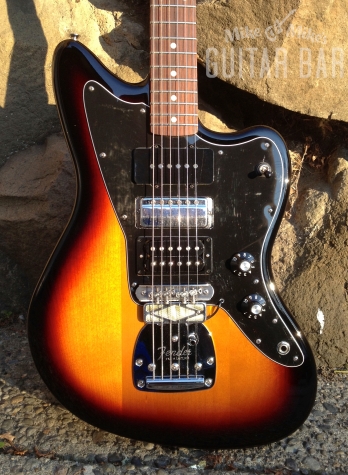
Here at Mike & Mike’s Guitar Bar, we couldn’t be more excited about July 4th. It’s three days after our shop’s anniversary (1 year, y’all!), my anniversary with my wife (3 years, y’all!) and the anniversary of our Nation’s independence (237 years, y’all!) so we’ve much to celebrate! And we LOVE to celebrate. I can’t speak for Other Mike, but I can tell you that in exercising my freedom on the freest day of the year I’ll be hanging with friends and family while eating grilled meats and drinking frosty brews, probably some Mike’s Hard Blackberry Lemonade because I like repetition. And also because I like adult fruit punch. I swear to God, if anyone tries to hand me a Silver Bullet I’m going to glare at them until they leave me alone.
When it comes to the best ways to share American pride, among them are belt buckles, bikinis, gaudy tattoos and, of course, the guitar. Yes, the guitar; is there anything more American?* Given the amount of red, white and blue guitars out there, that answer seems to be a flag-wavin’ HELL NO. In this day and age, everyone’s got a guitar – hell, even Obama plays a Jaguar.
Let’s take a look at some of the most patriotic guitars ever created, and we’ll rate just how proud they make Uncle Sam based on their individual patriotic flair. We’ll also try to give approximate prices, proving that freedom truly isn’t free.
1) Buck Owens Signature Fender Telecaster

Now that’s what I call patriotic: stately, refined pride. That’s a classy guitar, not some chaotic melange of blue stars and red stripes as if Uncle Sam got sick like so many other instruments. Gold hardware, three-tone sparkle finish and Buck’s signature on the headstock all makes this guitar as attractive as it is reverential, much like Buck’s deep love of his country.
Out of all the guitars we’ll look at in this post, this is one of the ones I’d really love to own. It’s a guitar even a dirty lib’ral could love! The caveat here is that this limited-edition run of guitars was actually made in Japan, for which we’ll have to reflect in the guitar’s rating.
Buck Owens Telecaster
Price: $1200-1500
Country of origin: Japan
Patriotism Rating: 888 (exactly 1/2 of 1776)
2) 1985 Gibson MAP

In 1985 Gibson did a limited run of guitars shaped like the 48 contiguous states of America, only nine of which are in this stars-and-stripes finish. Featuring a familiar electronics array, much like that of a Les Paul or an Explorer, these guitars have both style and substance while being a symbol of American craftsmanship. I mean, can you imagine trying to install binding on that thing? I would quit once I got to Michigan.
Because there are so few of these guitars, who’s to say exactly what the going rate would be. That finish is plenty cool, though, so if I came across one in the wild I’d snatch it up no matter what the going rate would be. There are a few of the natural-finish examples on eBay, with the sellers asking $3000, so I’m certain there’s a premium price attached to such a rare finish.
Being that this Gibson has such a rare, cool finish and is made in America, I’ll be awarding this one full points on the scale of patriotism.
1985 Gibson Map in Stars-and-Stripes finish
Price: $????
Country of Origin: USA!
Patriotism Rating: 1776
3) 1965 Mosrite Ventures “Salesman”
 In the 1960s, California-based guitar company Mosrite produced about 50 of these guitars know as “Salesman” guitars. The thought was that a Mosrite rep could walk into a guitar shop and say, “Here’s the Mosrite guitar, and these are your color choices: Red, White or Blue.” Easy, right?
In the 1960s, California-based guitar company Mosrite produced about 50 of these guitars know as “Salesman” guitars. The thought was that a Mosrite rep could walk into a guitar shop and say, “Here’s the Mosrite guitar, and these are your color choices: Red, White or Blue.” Easy, right?
Trouble is, I don’t want any of those individual colors, I want THIS ONE. I mean, just look at that! So dreamy.
Aside from the Ventures, many of our guitar heroes played Mosrite guitars including Kurt Cobain, Joe Maphis, Fred Smith of MC5 and Johnny Ramone.
1965 Mosrite Ventures model “Salesman”
Country of origin: ‘Merika
Price: ~$5000
Patriotism Rating: JFK riding a robot unicorn on the moon
4) Blueberry Guitars USA Eagle Thing

Holy shit. Evidently this was a custom order for a country artist that wanted everyone to know that his pride is bigger than yours. I can’t knock the kind of skill it takes to produce such an instrument, but subtlety is lost on this one. I mean, this thing is… well, I can’t describe this one to you as well as photos can…



And yes, the headstock shot from the beginning of the article is from this guitar. Can you imagine what this thing must be like in person? It must sound like the tears of an a bald eagle falling onto the Liberty Bell. And guess what: it’s not even made in America! This one’s from Canada, and the thought of someone in another country having to do this is hilarious. I do love Canada, though, and being that they’re our neighbors to the north I want to take this opportunity to say that we should hang sometime soon.
Blueberry Guitars USA Eagle Thing
Price: many thousands, I’m sure
Country of origin: Canada
Patriotism Rating:

Blueberry actually does really beautiful work. I’m picking on this instrument heavily but I do have deep respect for their craftsmanship and instruments. Check them out here.
5) Fender Wayne Kramer Signature (MC5)

I’m a huge MC5 fan, and I would totally Kick Out the Jams on this guitar. With US hardware, a Seymour Duncan ’59 humbucker in the middle position and an engraved “This Tool Kills Hate” neckplate, I would have no qualms about taking the stage with such a flashy Strat. It’s also worth mentioning that I’m not even a Strat guy!
This model has been relic’d to match the original, and is made in Mexico. “Mexico?!!”, you ask incredulously, mouth agape in shock. Yes. And it’s great. At least it’s an American brand, which is more than I can say for our next entry.
Fender Wayne Kramer Stratocaster
Country of origin: Mexico
Price: $999 new
Patriotism Rating: WELCOME TO EARF
6) Toby Keith’s Stars-and-Stripes Takamine

I’m sorry, but no. I mean, the other offshore-made guitars we liked were at the very least made by an American brand, but come on! Takamine?! Sure, they make good guitars, but TK’s not even trying here. Yeesh. How’s about you sing us another song about putting boots in terrorist’s asses or bringing American jobs back home. Let’s slap Old Glory on the front of a Takamine! Brilliant!
Irony? He’s swimming in it.
TK’s Takamine
Country of origin: Japan
Price: Custom
Patriotism Rating: McCarthyism
7) 1976 Gibson “Bicentennial” Firebird

Gold hardware and an understated tweak to commemorate 200 years of American history. It’s no Map, but it’s a nice nod.
1976 Gibson “Bicentennial” Firebird
Country of origin: USA
Price: $4,000-6500
Patriotism Rating: 177.6
8) Woody Guthrie’s “This Machine Kills Fascists” Gibson J-45

Woody Guthrie is an American legend, and the songs he wrote are just as poignant and effective today as they were when he penned them. Utilizing familiar folk melodies and the breadth of his experience gained while rambling around the country in train cars, Guthrie deeply loved his country and believed it was inseparable from its people, and aimed to protect her from fascists, singing his songs anywhere people were.
There’s much to be said about Guthrie’s legacy and music, but the song that’s probably the most well-known of his is also one of his most misunderstood: “This Land is Your Land”. Guthrie wrote that song in 1940 as a reaction to Irving Berlin’s “God Bless America”, which Guthrie thought was trite and complacent. The song, originally titled “God Blessed America”, is a beautiful example of his feelings of patriotism, far removed from today’s brand-name, fearful allegiance.
Above all, Guthrie believed in the capacity of people to care for one another, but he also believed that the country he cared for was going in the wrong direction, filled with greed and injustice. A socialist, Woody saw the wealthy profit from the labor of the poor, going from migrant camps to union halls, feeling what was happening around him.
I say that “This Land” is misunderstood because until I was in This Land, a play/musical I was in last year detailing Woody’s travels and songs by use of his personal journals and letters, I had never heard the whole song. Sure, everyone sings “This land is your land, this land is my land”, but I don’t know that I’ve heard anyone sing the other more damning verses before. I remember when my family was invited to see president George W. Bush at the York Fairgrounds in York PA, there was a group there singing patriotic tunes, and among them was “This Land”, and looking back those later verses were conspicuously absent. Here are those verses:
- This land is your land, this land is my land
- From
the California to the New York Island,
- From the Redwood Forest, to the Gulf stream waters,
God blessed America for me.- This land was made for you and me.
- As I went walking that ribbon of highway
- And saw above me that endless skyway,
- And saw below me the golden valley, I said:
- This land was made for you and me.
- I roamed and rambled and followed my footsteps
- To the sparkling sands of her diamond deserts,
- And all around me, a voice was sounding:
- This land was made for you and me.
- Was a high wall there that tried to stop me
- A sign was painted said: Private Property,
- But on the back side it didn’t say nothing —
- This land was made for you and me.
- When the sun come shining, then I was strolling
- In wheat fields waving and dust clouds rolling;
- The voice was chanting as the fog was lifting:
- This land was made for you and me.
- One bright sunny morning in the shadow of the steeple
- By the Relief Office I saw my people —
- As they stood hungry, I stood there wondering if
- This land was made for you and me.
As Greg Carter, the director of This Land said, “Woody will tear your flag down and give you a reason to pick it back up again.” And, having spent three months working in that play, singing his songs and playing his notes, I can honestly say that being so enveloped in Guthrie’s words and songs has taught me more about patriotism and heroism than the 30 years of fireworks, cookouts, pledges and elections ever could have. No one ever fights for a piece of cloth; they fight for the idea.
Woody Guthrie’s “This Machine Kills Fascists” Gibson J-45
Country of origin: United States of America
Price: Priceless
Patriotism Rating: Eleventy Billion
*Yes. The modern guitar has its roots in Spain, and further back, Rome. But of course, we’re a big ol’ melting pot, aren’t we?
-Michael James Adams


















































